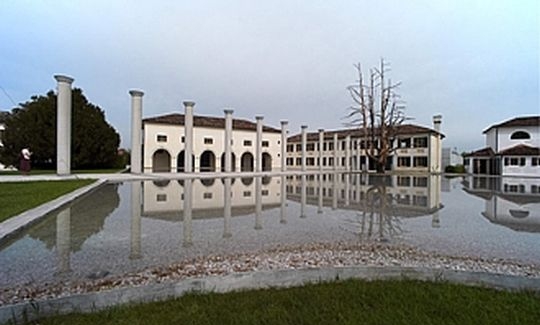Tadao Ando
Architect between East and West
Friday, 17.08.07
Sunday, 06.01.08
:
Dr. Atalia Karni
,Architect Arie Kutz
More info:
046030800This exhibition presents works by the renowned Japanese architect Tadao Ando, photographed and analyzed by Rudolf Klein, Professor of Architectural History. The display is based on Professor Klein's book of the same title (1996), of which the manuscript was a prize-winner in the Japan Foundation's competition (Tokyo, 1994).
Tadao Ando is considered as one of the great architects in Japan and throughout the world. His work is a remarkable synthesis of east and west. Born in 1941 in Osaka, Ando is self-educated. He has no formal qualifications from any school of architecture.
In his youth, Ando travelled to America, Europe and Africa. In 1969 he opened his architect's office in Osaka. He has designed many projects that have gained him international recognition, including Azuma House (1976) in Osaka, and has participated in international competitions such as the Kyoto Station Reconstruction Project (1990-1991). He also taught at the American universities of Yale, Columbia and Harvard, and at famous universities in Japan. As of 1979 his works have been exhibited in museums worldwide, including the Museum of Modern Art in New York and the Pompidou Centre in Paris. He has also received many international awards. In 1987 he was awarded the Mainichi Art Prize for his design of the Rokko Chapel; the Japan Art Grand Prix in 1994 for the Chikatsu Asuka Historical Museum; and the Pritzker Prize in 1995.
His works are influenced by traditional Japanese architecture and gardens, and by the works of illustrious Japanese architects of the 20th century - Kunio Maekawa (1905-86), Kenzo Tange (1913-2005), Kiyonori Kikutake (1928-1992), Fumihiko Maki (b. 1928) and others, as well as by the western tradition and the works of the great modern architects, among them Frank Lloyd Wright, Le Corbusier, Walter Gropius, and Ludwig Mies van der Rohe.
The works of the important Japanese architects of the 20th century combine Japanese concepts with western modernist concepts and culture, the western renaissance and mannerisms, contemporary western modernism and post-modernism. In the designs of such architects as Kisho Kurokawa (b. 1934), Arata Isozaki (b. 1931) and Tadao Ando, there are quotations and allusions to the architectural styles of Michelangelo Buonarroti 1475-1564); Claude Nicolas Ledoux (1736-1806), Etienne-Louis Boullee (1728-1799), the late 18th century French architects who used neo-platonic forms; as well as to western 20th century architecture.
The concept of the space, focal to Ando's work, is a basic premise, both in the western modernistic world view, and in the Japanese concept of space-time. The parallels between east and west are pronounced. The Japanese word for space, ku-kan, embodies both space and time. Ku means "space" or "emptiness", the void between heaven and earth. Kan (or ma) is the interval in space and/or time. The historian of architecture Siegfried Gideon has discussed how conspicuous this concept is in 20th century architects' works.
Ando is influenced by the gardens of the Orient - the promenades along ramps like the pathways in Chinese gardens, the complicated and fascinating pilgrims' routes through Buddhist temples such as the Hasedera Temple in Nara Province, as well as the traditional Japanese strolling gardens. In Ando's projects one can immediately identify a direct reference to gardens such as that of the Katsura Villa and, at the same time, similarities with modern projects such as Le Corbusier's Villa Savoye (1929-1931) and the Barcelona Pavilion (1928-1929) of Mies van der Rohe. Movement along the sacred way to the Christian cross is another example of the complex experience of motion in Ando's work, again linking East and West, Buddhism, Shinto, and Christianity.
The aspiration to simplicity and minimalism, the pure volumes and voids are characteristics of the works of the great modern architects as well as in Ando's work. These also derive from Zen Buddhism's principles of simplicity and the aesthetic of the void and nothingness, the "in-between" (ma). The Zen philosophy has influenced Japanese architecture in temples and gardens alike. Zen gardens, like the 15th century Ryoanji Temple Garden in Kyoto, are closed, internalized, defining the void. Such spaces are common both to eastern philosophy and western modernism, to traditional and contemporary Japanese architecture, and contemporary western architecture. Ando too uses simple geometric forms and straight lines. His compositions are balanced between symmetry and asymmetry, as in modern spaces.
Ando's spaces have much in common with the tea-house of the Tea-Master Sen no Rikyu (1522-1991). Both are modest, simple, closed and concentrated, quietly serene and pure. Both have the same spatial enclosures, subdued lighting, the same chiaroscuro in which this internal world is a microcosm in its own right. Ando's geometric volumes derive simultaneously from the traditional Japanese pure volumes and the platonic "architecture of the box" of contemporary western architecture. Ando selects his materials carefully, according to his intentions, usually preferring rough concrete, in the aesthetic spirit of the "Way of Tea", wabi (the aspiration to simplicity), together with quiet, almost monochromatic colour schemes. The texture of his materials is simple, unrefined, deliberately coarse. Ando distils his aesthetic world in his use of concrete.
The exhibition focuses on five of Tadao Ando's best-known projects:
Church of the Light (1988-1989) at Ibaraki, near Osaka; Chapel on Mount Rokko (1985-1986), near Kobe; Chikatsu Asuka Historical Museum (1991-1994), Osaka Prefecture; Garden of Fine Arts (1993-1994), Kyoto; and Fabrica Benetton Research Centre (1993-1996), Treviso, Italy.
There is, here, a connection with the past that is beyond time. It is a superb expression of Tadao Ando's artistry in its meeting of old and new, completing the circle of east and west, tradition and progress, past and future.




